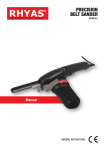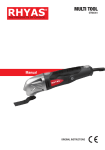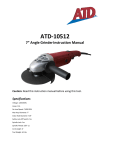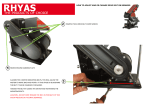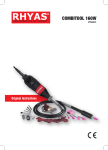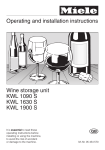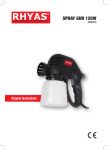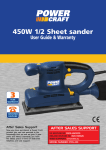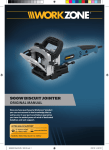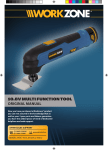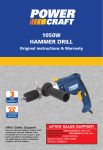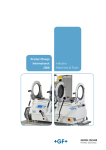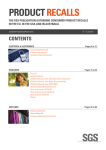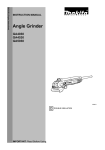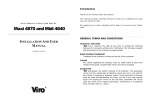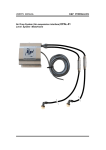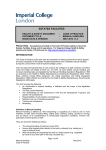Download ANGLE POLISHER
Transcript
ANGLE POLISHER AGM4005 Manual ORIGINAL INSTRUCTIONS EN 3 2 5 4 6 1 Fig. 1 Fig. 2 Fig. 3 2 EN 2 5 4 3 1 Fig. 4 Fig. 5 B Fig. 6 A 3 EN ANGLE POLISHER AGM4005 Thank you for buying this Rhyas product. All our products are manufactured to the highest standards of performance and safety. As part of our brand commitment we provide excellent customer service and a 12 month warranty. We hope you will enjoy using this product for many years to come. The numbers in the text refer to the diagrams on pages 2-3. ead this operators guide carefully, R before using the machine. Ensure that you know how the machine works, and how it should be operated. Maintain the machine in accordance with the instructions, and make certain that the machine functions correctly. Keep this operator’s guide and other enclosed documentation with the machine. Contents 1. Machine data 2. Safety instructions 3. Assembly 4. Use 5. Service & maintenance Introduction This product is for non-professional use and designed for polishing and light sanding only; not fur use in any other manner. 1. Machine data Technical specification Voltage Frequency Power input No-load speed Disc diameter Spindle dimension Weight Lpa (sound pressure) Lwa (sound power) Vibration value 4 230 V 50 Hz 1400 W 0-3200/min 180 mm M 14 3.4 kg 85+3 dB(A) 96+3 dB(A) 11.59+1.5 m/s2 Vibration level The vibration emission level stated in this instruction manual has been measured in accordance with a standardised test given in EN 60745; it may be used to compare one tool with another and as a preliminary assessment of exposure to vibration when using the tool for the applications mentioned - using the tool for different applications, or with different or poorly maintainted accessories, may significantly increase the exposure level - the times when the tool is switched off or when it is running but not actually doing the job, may signifi cantly reduce the exposure level Protect yourself against the effects of vibration by maintaining the tool and its accessories, keeping your hands warm, and organising your work patterns. Contents of packing 1 Angle polisher 1 U-shaped handle 1 Hexagon key 1 Instruction manual 1 Safety instructions 1 Warranty card Check the machine, loose parts and accessories for transport damage. Features Fig. 1 1. On/off switch 2. Speed controle 3. U-shaped handle 4. Pad holder 5. Spindle lock 6. Switch lock 7. Carbon brush indicator 2. Safety instructions Explanation of the symbols enotes risk of personal injury, loss of D life or damage to the machine in case of non-observance of the instructions in this manual. EN Indicates electrical shock hazard. Immediately unplug the plug from the mains electricity in the case that the cord gets damaged and during maintenance. Use spindle lock only in stand still mode. Keep bystanders away. Wear ear and eye protection. Wear protective gloves. Variable speed control Safety Warnings Common for Grinding or Abrasive Cutting-Off Operations: a) This power tool is intended to function as a sander, wire brush, polisher. Read all safety warnings, instructions, illustrations and specifications provided with this power tool. Failure to follow all instructions listed below may result in electric shock, fire and/or serious injury. b) Operations such as grinding, or cutting-off are not recommended to be performed with this power tool. Operations for which the power tool was not designed may create a hazard and cause personal injury. c) Do not use accessories which are not specifically designed and recommended by the tool manufacturer. Just because the accessory can be attached to your power tool, it does not assure safe operation. d) The rated speed of the accessory must be at least equal to the maximum speed marked on the power tool. Accessories running faster than their rated speed can break and fly apart. e) The outside diameter and the thickness of your accessory must be within the capacity rating of your power tool. Incorrectly sized accessories cannot be adequately guarded or controlled. f) The arbour size of wheels, flanges, backing pads or any other accessory must properly fit the spindle of the power tool. Accessories with arbour holes that do not match the mounting hardware of the power tool will run out of balance, vibrate excessively and may cause loss of control. g) Do not use a damaged accessory. Before each use inspect the accessory such as abrasive wheels for chips and cracks, backing pad for cracks, tear or excess wear, wire brush for loose or cracked wires. If power tool or accessory is dropped, inspect for damage or install an undamaged accessory. After inspecting and installing an accessory, position yourself and bystanders away from the plane of the rotating accessory and run the power tool at maximum no-load speed for one minute. Damaged accessories will normally break apart during this test time. h) Wear personal protective equipment. Depending on application, use face shield, safety goggles or safety glasses. As appropriate, wear dust mask, hearing protectors, gloves and workshop apron capable of stopping small abrasive or workpiece fragments. The eye protection must be capable of stopping flying debris generated by various operations . The dust mask or respirator must be capable of filtrating particles generated by your operation. Prolonged exposure to high intensity noise may cause hearing loss. i) Keep bystanders a safe distance away from work area. Anyone entering the work area must wear personal protective equipment. Fragments of workpiece or of a broken accessory may fly away and cause injury beyond immediate area of operation. j) Hold power tool by insulated gripping surfaces only, when performing an operation where the cutting accessory may contact hidden wiring or its own cord. Cutting accessory contacting a “live” wire may make exposed metal parts of the power tool “live” and shock the operator. k) Position the cord clear of the spinning accessory. If you lose control, the cord may be cut or snagged and your hand or arm may be pulled into the spinning accessory. l) Never lay the power tool down until the accessory has come to a complete stop. The spinning accessory may grab the surface and pull the power tool out of your control. 5 EN m)Do not run the power tool while carrying it at your side. Accidental contact with the spinning accessory could snag your clothing, pulling the accessory into your body. n) Regularly clean the power tool’s air vents. The motor’s fan will draw the dust inside the housing and excessive accumulation of powdered metal may cause electrical hazards. o) Do not operate the power tool near flammable materials. Sparks could ignite these materials. p) Do not use accessories that require liquid coolants. Using water or other liquid coolants may result in electrocution or shock. Kickback and Related Warnings Kickback is a sudden reaction to a pinched or snagged rotating wheel, backing pad, brush or any other accessory. Pinching or snagging causes rapid stalling of the rotating accessory which in turn causes the uncontrolled power tool to be forced in the direction opposite of the accessory’s rotation at the point of the binding. For example, if an abrasive wheel is snagged or pinched by the workpiece, the edge of the wheel that is entering into the pinch point can dig into the surface of the material causing the wheel to climb out or kick out. The wheel may either jump toward or away from the operator, depending on direction of the wheel’s movement at the point of pinching. Abrasive wheels may also break under these conditions. Kickback is the result of power tool misuse and/or incorrect operating procedures or conditions and can be avoided by taking proper precautions as given below. a) Maintain a firm grip on the power tool and position your body and arm to allow you to resist kickback forces. Always use auxiliary handle, if provided, for maximum control over kickback or torque reaction during start-up. The operator can control torque reactions or kickback forces, if proper precautions are taken. b) Never place your hand near the rotating acces sory. Accessory may kickback over your hand. c) Do not position your body in the area where power tool will move if kickback occurs. Kickback will propel the tool in direction opposite to the wheel’s movement at the point of snagging. d) Use special care when working corners, sharp edges etc. Avoid bouncing and snagging 6 the accessory. Corners, sharp edges or bouncing have a tendency to snag the rotating accessory and cause loss of control or kickback. e) Do not attach a saw chain woodcarving blade or toothed saw blade. Such blades create frequent kickback and loss of control. Safety Warnings Specific for Grinding and Abrasive Cutting-Off Operations: a) Use only wheel types that are recommended for your power tool and the specific guard designed for the selected wheel. Wheels for which the power tool was not designed cannot be adequately guarded and are unsafe. b) The guard must be securely attached to the power tool and positioned for maximum safety, so the least amount of wheel is exposed towards the operator. The guard helps to protect operator from broken wheel fragments and accidental contact with wheel. c) Wheels must be used only for recommended applications. For example: do not grind with the side of cut-off wheel. Abrasive cut-off wheels are intended for peripheral grinding, side forces applied to these wheels may cause them to shatter. d) Always use undamaged wheel flanges that are of correct size and shape for your selected wheel. Proper wheel flanges support the wheel thus reducing the possibility of wheel breakage. Flanges for cut-off wheels may be different from grinding wheel flanges. e) Do not use worn down wheels from larger power tools. Wheel intended for larger power tool is not suitable for the higher speed of a smaller tool and may burst. Additional Safety Warnings Specific for Abrasive Cutting-Off Operations: a) Do not “jam” the cut-off wheel or apply excessive pressure. Do not attempt to make an excessive depth of cut. Overstressing the wheel increases the loading and susceptibility to twisting or binding of the wheel in the cut and the possibility of kickback or wheel breakage. b) Do not position your body in line with and behind the rotating wheel. When the wheel, at the point of operation, is moving away from your body, the possible kickback may propel the spinning wheel and the power tool directly at you. EN c) When wheel is binding or when interrupting a cut for any reason, switch off the power tool and hold the power tool motionless until the wheel comes to a complete stop. Never attempt to remove the cut-off wheel from the cut while the wheel is in motion otherwise kickback may occur. Investigate and take corrective action to eliminate the cause of wheel binding. d) Do not restart the cutting operation in the workpiece. Let the wheel reach full speed and carefully reenter the cut. The wheel may bind, walk up or kickback if the power tool is restarted in the workpiece. e) Support panels or any oversized workpiece to minimize the risk of wheel pinching and kickback. Large workpieces tend to sag under their own weight. Supports must be placed under the workpiece near the line of cut and near the edge of the workpiece on both sides of the wheel. f) Use extra caution when making a “pocket cut” into existing walls or other blind areas. The protruding wheel may cut gas or water pipes, electrical wiring or objects that can cause kickback. Special safety instructions • Check that the maximum speed indicated on the disc corresponds to the maximum speed of the machine. The speed of the machine must not exceed the value on the disc. • Make sure that the dimensions of the disc cor respond to the specifications of the machine. • Make sure that the disc has been mounted and fastened properly. Do not use reducing rings or adapters to make the disc fit properly. • Never use this machine single handed. Always use both hands to operate the machine. • Do not touch any rotating parts. • Make sure the wool bonnet is not contacting the workpiece before the machine is switched on. • Do not touch the workpiece immediately after operation. It may be hot. • Warning: The wheel still rotates after the machine has been switched off • Hold the machine by the insulated grips when performing an operation where contact can be made with hidden wiring or its own cord. • Before use, inspect the disc for any damage. Do not use discs which are crack-ed, ripped or otherwise damaged. • Before use, let the machine run idle for 30 seconds. Immediately switch off the machine in case of abnormal vibrations or occurrence of another defect. Carefully inspect the machine and disc before switching the machine on again. • Always wear safety goggles and hearing protection. • Ensure that mounted wheels and points are fitted in accordance with the manufacturer’s instructions. • For tools intended to be fitted with threaded hole wheel, ensure that the thread in the wheel is long enough to accept the spindle length. • Ensure that ventilation openings are kept clear when working in dusty conditions. If it should become nessesary to clear dust, first disconnect the tool from the mains supply (use non metallic objects) and avoid damaging internal parts. • Though poor conditions of the electrical mains, shortly voltage drops can appear when starting the equipment. This can influence other equipment (eq. blinking of a lamp). If the mains-impedance Zmax <0.348 Ohm, such disturbances are not expected. (In case of need, you may contact your local supply authority for further information. Immediately switch off the machine when: • Excessive sparking of the carbon brushes and verticiliosis in the collector. • Interruption of the mains plug, mains lead or mains lead damage. • Defect switch • Smoke or stench of scorched isolation Electrical safety When using electric machines always observe the safety regulations applicable in your country to reduce the risk of fire, electric shock and personal injury. Read the following safety instructions and also the enclosed safety instructions. Always check that the power supply corresponds to the voltage on the rating plate. Your machine is double insulated; therefore no earthwire is required. 7 EN Replacing cables or plugs Immediately throw away old cables or plugs when they have been replaced by new ones. It is dangerous to insert the plug of a loose cable in the wall outlet. Using extension cables Only use an approved extension cable suitable for the power input of the machine. The minimum conductor size is 1.5 mm2. When using a cable reel always unwind the reel completely. 3. Assembly Prior to mounting an accessory always unplug the tool. Assembling the handle Fig. 2 The handle is suitable for either left or righthanded use. • Install the handle in such way that the holes match the screwholes on the machine. • Tighten the handle with the bolts and hexagon key. Assembling accessoires Fig. 3 • Press the spindle lock (5) • Screw and tighten the pad holder on the spindle • Depress the spindle lock (5) • Mount the polishing pad onto the pad holder. Accessoires Fig. 4 Sanding paper (1) This is used for sanding and polishing new paints and plastics. Fiber pad (2) This is used in combination with other pads.(3 & 4) Polishing pad (3) In combination with the fiber pad (2), this is used for high lustre polishing and waxing. The plastified layer inside assures the maximum use of the used wax. Wool polishing pad (4) This is used for a high gloss finish. To be used in combination with the fiber pad (2). 8 4. Use Always follow the safety instructions and keep to the applicable regulations. • Hold the machine away from the workpiece when switch it on and off. • Always first switch the machine off after use before removing the plug from the socket. Speed control Fig. 5 The speed of the disc can be controlled with the rotary knob on top of the handle. The higher the position, the higher the speed. When using wax on the polishing pad do not start at a high speed. Switching on and off Fig. 6 • This machine is equipped with a safety switch. • Start the machine by pressing the “lock off” (B) button (to disengage the switch) and switch on the machine (A). Switch Off Release the switch (A). The polisher will continue to run after it is turned off. Only lay the machine down once the motor has completely stopped turning. Do not put the machine on a dusty surface. Dust particles can penetrate the machine. Never use the spindle lock to stop the motor turning. Carbon brush indicator Normally the carbon brush indicator (7) lights green to indicate the machine has a live connection. When the carbon brushes are worn, the carbon brush indicator (7) will light red. EN 5. Service & maintenance Make sure that the machine is not live when carrying out maintenance work on the motor. This machine has been designed to operate over a long period of time with a minimum of maintenance. Continuous satisfactory operation depends upon proper machine care and regular cleaning. Trouble shooting Should the machine fail to function correctly, a number of possible causes and the appropriate solutions are given below: 1. Machine fails to operate. • Power turned off. • (Extension) cable damaged. 2. The motor does not reach maximum speed. • The extension cable is too thin and/or too long. • The mains voltage is lower than 230 V. 3. Machine overheats. • Air vents are blocked. Clean them with a dry cloth. • The machine has been overloaded. Use the machine for the purpose it is made for Faults Should a fault occur, e.g. after wear of a part, please contact the service address on the warranty card. In the back of this manual you find an exploded view showing the parts that can be ordered. Environment To prevent damage during transport, the appliance is delivered in a solid packaging which consists largely of reusable material. Therefore please make use of options for recycling the packaging. aulty and/or discarded electrical or F electronic apparatus have to be collected at the appropriate recycling locations. Warranty The warranty conditions can be found on the separately enclosed warranty card. The product and the user manual are subject to change. Specifications can be changed without further notice. 4. The motor does not run smoothly or is excessively sparking. • There’s dirt inside the motor or the carbon brushes are worn. • Replace the carbon brushes or bring the machine to a specialized repair centre. Repairs and servicing should only be carried out by a qualified technician or service firm. Cleaning Keep the ventilation slots of the machine clean to prevent overheating of the engine. Regularly clean the machine housing with a soft cloth, preferably after each use. Keep the ventilation slots free from dust and dirt. If the dirt does not come off use a soft cloth moistened with soapy water. Never use solvents such as petrol, alcohol, ammonia water, etc. These solvents may damage the plastic parts. 9 EN Spare parts list PositionDescription 1 Pad holder 7 Bearing 6202 ZZ 10 Spindle gear 12Bearing 14 - 17 Handle complete 18 - 20 Locking pin assembly 21Gearbox 22 Bearing 6201 ZZ 26Rotor 27 Bearing 608 ZZ 33Stator 37 Carbon brush set 40 Speed regulation 44Switch 10 No. 409486 806202 409480 409673 409481 409674 409675 806201 409482 800608 409483 409484 409676 409485 EN 11 EN 12 EN 13 EN General Safety INSTRUCTIONS Warning! Read all instructions. Failure to follow all instructions listed below may result in electric shock, fire and/or serious injury. The term “power tool” in all of the warnings listed below refers to your mains operated (corded) power tool or battery operated (cordless) power tool. Save these instructions. 1) Work area a.Keep work area clean and well lit. Cluttered and dark areas invite accidents. b.Do not operate power tools in explosive atmospheres, such as in the presence of flammable liquids, gasses or dust. Power tools create sparks which may ignite the dust of fumes. c.Keep children and bystanders away while operating a power tool. Distractions can cause you to lose control. 2)Electrical safety a.Power tool plugs must match the outlet. Never modify the plug in any way. Do not use any adapter plugs which earthed (grounded) power tools. Unmodified plugs and matching outlets will reduce risk of electric shock. b.Avoid body contact with earthed or grounded surfaces such as pipes, radiators, ranges and refrigerators. There is an increased risk of electric shock if your body is earthed or grounded. c.Do not expose power tools to rain or wet conditions. Water entering a power tool will increase the risk of electric shock. d.Do not abuse the cord. Never use the cord for carrying, pulling or unplugging the power tool. Keep cord away from heat, oil, sharp edges or moving parts. Damaged or entangled cords increase the risk of electric shock. e.When operating a power tool outdoors, use an extension cord suitable for outdoor use. Use of a cord suitable for outdoor use reduces the risk of electric shock. Always use tool in conjunction with a residual circuit breaker device. 3) Personal safety a.Stay alert, watch what you are doing and use common sense when operating a power tool. Do not use a power tool while you are tired or under the influence of drugs, alcohol or medication. A moment of inattention while operating power tools may result in serious personal injury. b.Use safety equipment. Always wear eye protection. Safety equipment such as dust mask, non-skid safety shoes, hard hat, or hearing protection used for appropriate conditions will reduce personal injuries. 14 c.Avoid accidental starting. Ensure the switch is in the off position before plugging in. Carrying power tools with your finger on the switch or plugging in power tools that have the switch on invites accidents. d.Remove any adjusting key or wrench before turning the power tool on. A wrench or a key left attached to a rotating part of the power tool may result in personal injury. e.Do not overreach. Keep proper footing and balance at all times. This enables better control of the power tool in unexpected situations. f.Dress properly. Do not wear loose clothing or jewellery. Keep your hair, clothing and gloves away from moving parts. Loose clothes, jewellery or long hair can be caught in moving parts. g.If devices are provided for the connection of dust extraction and collection facilities, ensure these are connected and properly used. Use of these devices can reduce dust related hazards. h.Use clamps or a vice to hold work. It’s safer than using your hand and it frees both hands to operate tool. 4) Power tool use and care a.Do not force the power tool. Use the correct power tool for your application. The correct power tool will do the job better and safer at the rate for which it was designed. b.Do not use the power tool if the switch does not turn it on and off. Any power tool that cannot be controlled with the switch is dangerous and must be repaired. c.Disconnect the plug from the power source before making any adjustments, changing accessories, or storing power tools. Such preventive safety measures reduce the risk of starting the power tool accidentally. d.Store idle power tools out of the reach of children and do not allow persons unfamiliar with the power tool or these instructions to operate the power tool. Power tools are dangerous in the hands of untrained users. e.Maintain power tools. Check for misalignment or binding of moving parts, breakage of parts and any other condition that may affect the power tools operation. If damaged, have the power tool repaired before use. Many accidents are caused by poorly maintained power tools. f.Keep cutting tools sharp and clean. Properly maintained cutting tools with sharp cutting edges are less likely to bind and are easier to control. g.Use the power tool, accessories and tool bits etc., in accordance with these instructions and in the manner intended for the particular type of power tool, taking into account the working conditions and the work to be performed. Use of the power tool for operations different from intended could result in hazardous situation. EN h.Damaged switches must be replaced at a customer service repair centre. Do not use power tools that cannot be switched on and off. i.Do not leave power tools unattended while they are switched on. Always switch off the tool and wait until it has come to a full standstill before leaving. j.If the mains cable has been damaged, it must be replaced with a special mains cable. These can be obtained from the manufacturer or the manufacturer’s customer service department. The mains cable may only be replaced by the manufacturer, the manufacturer’s customer service department or equally qualified persons. c.Use power tools only with specifically designated battery packs. Use of any other battery packs may create a risk of injury and fire. d.When battery pack is not in use, keep it away from other metal objects like paper clips, coins, keys, nails, screws, or other small metal objects that can make a connection from one terminal to another. Shorting the battery terminals together may cause burns of a fire. e.Under abusive conditions, liquid may be ejected from the battery; avoid contact. If contact accidentally occurs, flush with water. If liquid contacts eyes, additionally seek medical help. Liquid ejected from the battery may cause irritations or burns. 5) Battery tool use and care a.Ensure the switch is in the off position before inserting battery pack. Inserting the battery pack into power tools that have the switch on invites accidents. b.Recharge only with the charger specified by the manufacturer. A charger that is suitable for one type of battery pack may create a risk of fire when used with another battery pack. 6)Service a.Please use a qualified expert who uses original replacement parts to repair your power tool. This will ensure proper functioning of the power tool. b.Caution! The use of any accessories or additional tools other than those recommended in this manual may lead to an increased risk of injury. Only use original replacement parts. DECLARATION OF CONFORMITY AGM4005 (EN)We declare under our sole responsibility that this product is in conformity with directive 2011/65/EU of the European parliament and of the council of 9 June on the restriction of the use of certain hazardous substances in electrical and electronic equipment is in conformity and accordance with the following standards and regulations: EN 55014-1, EN 55014-2, EN 60745-2-3 EN 60745-1, EN 61000-3-2, EN 61000-3-3 2006/42/EC, 2006/95/EC, 2004/108/EC, 2002/96/EC, 2011/65/EU Zwolle, 01-05-2014 W. Dekens CEO Mactool Industrial BV It is our policy to continuously improve our products and we therefore reserve the right to change the product specification without prior notice. Mactool Industrial BV • Lingenstraat 6 • 8028 PM • Zwolle The Netherlands 15 1406-05
















